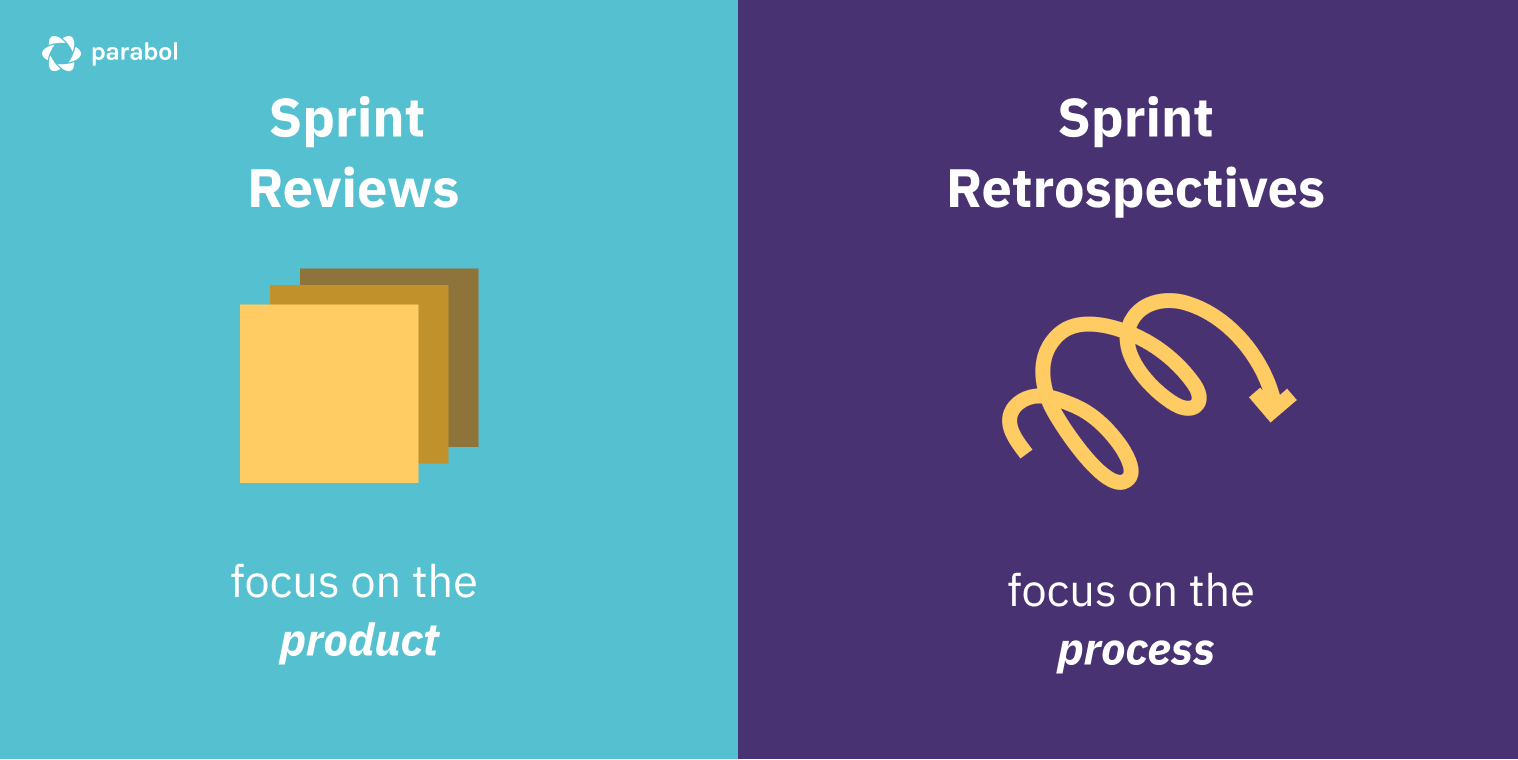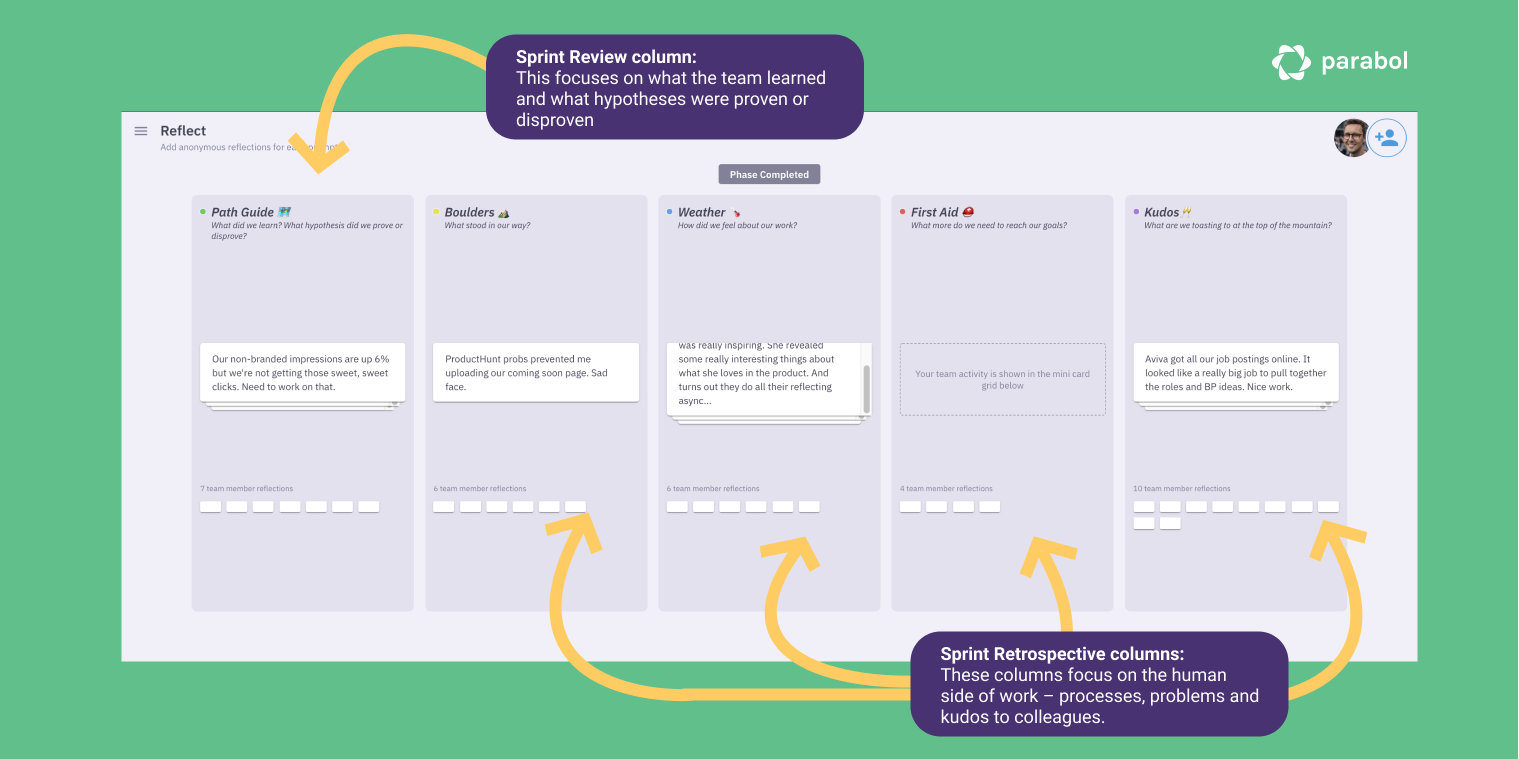Sprint Reviews vs Sprint Retrospectives for Remote Teams

Even the smartest people in the world can fall into the chaos of long, useless meetings when they lack the right processes for effective collaboration and improvement. That risk grows exponentially on remote teams, where time zones and home distractions are a key factor in how engaged someone is in a meeting.
Sprint Reviews and Sprint Retrospectives are two meetings in which you simply can’t afford to have your team snoozing.
Now that so many agile teams are operating remotely, this blog sets out to make sure your remote Sprint Reviews and remote Retrospectives are distinct from each other, effective, and worth the time invested.
And it helps you to overcome some of the common problems you might face when running remote Retrospectives and Sprint Reviews.
This guide on Sprint Reviews vs Sprint Retrospectives is broken down into five parts:
Understanding the first two steps of a Sprint
The first thing to know about Sprint Reviews and Retrospectives is that they are the final two steps of an agile team’s Sprint.
.png)
The first two steps are:
1️⃣ Sprint Planning: The planning process identifies what work will be completed during the Sprint. This is commonly called the Sprint Goal. Once selected, this agenda of tasks and user stories is locked in and everyone on the team commits to delivering the chosen outcome. Sprint planning may also involve backlog refinement and agile estimation of user stories to ensure the right volume of work is taken into the Sprint.
2️⃣ Standups: Typically held daily, these short (10-15 min) meetings are meant to keep everyone on top of the work each team member is doing. They are also times for people to share any obstacles they are facing so these can be removed quickly and everyone can continue to work in flow toward the Sprint Goal.
These two steps are essential, since they detail the work to be done and ensure everyone can focus on their work with minimal distractions or problems.
Sprint reviews vs Sprint Retrospectives:
What’s the difference?
The final two steps are the Sprint Review and Sprint Retrospective. These meetings take place at the end of the Sprint when the team has completed its work for the Sprint.

3️⃣ Sprint Reviews: At the end of a Sprint the team meets to present the work they have achieved and review it together. The focus of the meeting is on how the team can improve the Sprint outcome and to overall review what was achieved. A team building a digital product together might discuss what parts of the product are finished and what needs more work. Teams may also determine in this meeting if they met their Sprint Goal or not.
4️⃣ Sprint Retrospectives: Typically held after the Sprint Review, Sprint Retrospectives are designed to help teams build a habit of continuous process improvement. They provide a time for teams to come together and review how they worked together over the Sprint. Retrospectives may include discussion of roadblocks, workflow issues and difficult team dynamics. But they are also a place to celebrate what went well, to give kudos to colleague, and to discuss how successes can be replicated in the future.
Similarities between Sprint Reviews and Sprint Retrospectives
The key similarity between Sprint reviews vs Retrospectives is they both focus on improvement and are both done at the end of a Sprint.
Both meetings involve a process of looking back over what was achieved and thinking about how work can be improved.
Good Sprint Reviews and Sprint Retrospectives share three other key traits:
Psychological safety: Any time improvements are discussed, the whole team needs to feel they can be honest without fear of retribution. For this exact reason, teams usually start meetings with simple icebreakers, which are meant to build trust between colleagues. Psychological safety helps team members feel confident openly discussing difficult issues. This helps teams to better address issues instead of sweeping them under the rug.
✅ Issues, not people: Some reviews and retrospectives will bring up difficult challenges, problems, or failures. That’s why it’s critical these meetings only focus on resolving and discussing issues, rather than assigning blame to others.
Limited prep time: Reviews and retrospectives are intended to offer consistent incremental improvements. Further, they are planned at the end of the Sprint, so information is fresh in everyone’s minds. Therefore, neither offer much prep time because that would start to take away from the team’s ability to deliver on the Sprint Goal.
Differences between Sprint Reviews and Sprint Retrospectives
The key difference is that a Sprint Review focuses on improving so the team can deliver a better product, whereas a Sprint Retrospective focuses on improving the overall system so the team can work more harmoniously and find flow together.
Sprint Reviews focus on what’s been “shipped”
At the end of each Sprint, the team looks at what deliverables have been shipped or marked as done. The review is a time to assess whether the workload was fair, whether the team was equipped to deliver the objective, and whether the definition of ‘shipped’ or ‘done’ needs to change due to other circumstances affecting the product.
Whereas Sprint Retrospectives focus on the human side of work
Because Sprints are inherently about teamwork, Sprint Retrospectives seek to improve the overall Sprint process, encourage certain actions, course-correct if external circumstances harmed the Sprint, and discuss other issues that may have arisen and impacted the Sprint’s success.
The goal of a retrospective is similar to the Japanese concept of ‘kaizen,’ which means continuous improvement. Each retrospective looks for small ways to get just a bit better. Over time, each small improvement compounds and the team becomes significantly more capable.
⏱ Sprint review and retrospective meetings may be different lengths
Typically, a Sprint Review meeting is scheduled for one hour per week of the Sprint if there’s a lot to discuss. On the other hand, retrospectives are typically held once every two weeks, with 30-45 minutes budgeted to cover each week of the Sprint. There is some debate about how frequently to run retrospectives or how long retrospective meetings should be, so the 30-45 min per week is a guideline. Ultimately, each team leader will need to pick a time that is long enough to discuss important issues but not so long that people get bored of the process.
Sprint Review and Sprint Retrospective meeting agendas [templates]
Because Sprint Reviews and Sprint Retrospectives have different outcomes, their meeting agendas are slightly different.
Here are two basic agenda templates you can use when planning your meetings:
Sprint Review agenda template
|
1. Open the meeting
|
Introduce and welcome everyone to the review and optionally run an icebreaker together
|
|
2. Stakeholder introduction
|
Make sure all stakeholders in the meeting are introduced so the team is aware of who is present and why
|
|
3. Review agenda
|
The product owner/scrum master presents the agenda for the meeting
|
|
4. Check product increments
|
The development teams shows what has been implemented and may also demo the product
|
|
5. Feedback on the product
|
Everyone in the meeting discusses what went well, what went poorly, and opportunities for improvement to the product or ‘shipped’ process
|
|
6. Present the backlog
|
Whatever was not done – and improvement opportunities the team committed to – are documented to inform the next Sprint Planning process
|
Sprint Retrospective agenda template
|
1. Icebreaker
|
Build awareness of teammates’ personal context and create psychological safety
|
|
2. Reflect
|
Share anonymously what did/didn’t work, for you using a retrospective template
|
|
3. Group
|
Review the team’s reflections and group them into common themes
|
|
4. Vote
|
Each team member selects 2-3 issues that are most important to discuss
|
|
5. Discuss
|
Look at which topics gained the most votes, discuss those issues and create an action plan for how to improve in the next Sprint
|
For more on running an effective Sprint Retrospective, check out our comprehensive guide.
How to run effective remote Sprint Reviews and Retrospectives
When everyone’s in the office, Sprint Reviews and Retrospectives are typically done in synchronous meetings. That could theoretically happen with remote teams as well, but there are some specific concerns to be aware of.
Choosing when to host asynchronous vs synchronous meetings
One of the big questions in remote work is whether meetings need to happen synchronously – with everyone gathered at the same time, typically on a video call.
Some things that may impact your decision include:
- Team size
- Team preference for meeting style
- Goals of each meeting
- Time zones everyone operates in
As a best practice for remote work, do as much asynchronously as you can without going overboard.
Since Sprint Reviews and Retrospectives have some inherently sensitive material to discuss, it’s best to have some synchronous parts of the process as well.
We’ve found a half-half approach can work well.
For both Sprint Reviews and Retrospectives, team members can asynchronously document what went well, what didn’t, and what they believe can or should be improved. Then host a synchronous team meeting to discuss the options. That way, everyone can speak their mind without taking up too much time in everyone’s day.
For more tips check out our guide on how to run an asynchronous retrospective.
Creating novelty in meetings
Every meeting can get boring when it’s repeated over and over. To keep your remote Sprint Reviews and Retrospectives interesting, try changing up the format.
.png)
You could try Sprint retrospective frameworks such as:
All frameworks follow the key retrospective goal of improvement. The different framework structures offer both novelty and a way to approach the problem from a different perspective.
Sprint Reviews are typically more fixed in nature, so you can add more novelty by building in an icebreaker question or a team-building game.
Teams that work in agile marketing or other disciplines may want to adapt their Sprint Review by combining an analysis or review section in their Retrospective.

The growth team at Parabol do this using a combined template that features a specific section for data-related reflections on how a campaign is doing or to share learnings from experiments.
Leaving room for humanity in a remote world
When you can’t see your colleagues face to face or have quick tap-on-the-shoulder conversations, Sprint Reviews and Retrospectives can feel emotionally draining.
Even as remote workers are more willing to talk about mental health struggles with colleagues, there’s still far less dialogue between remote teams, and very limited opportunities to read body language, which can lead to emotional overheating (see how to handle that below in the “common issues” section).
To balance this need for humanity with the goals of the meeting, think about:
- Reinforcing the rule that the meetings are about ideas, not people
- Reiterate the commitment everyone makes in these meetings: don’t make it personal and don’t take it personally
- Root out thinly veiled commentary clearly about one person (“Well we would have done better if someone hadn’t messed this up”) and redirect it to be solely about the issue at hand
- Be rigorous about the meeting agenda. Sprint reviews are about product. Sprint retrospectives are about process. Keep them separate.
Dealing with common Sprint Review and Retrospective problems
Not every Sprint Review or Sprint Retrospective goes well. It’s fairly easy for these meetings to go off the rails.
Here are four common issues to look for and what to do about them.
1. People not caring
If you’re running meetings and notice that some people are disengaged, encourage them to speak up in the meeting and keep going. After the fact, have a sit down chat with them to ask what might be going on. You may uncover a need to add more novelty to the meeting or you might uncover something deeper affecting that individual. Either way, it’s good to get that information out.
2. People not talking
When people suddenly stop talking in meetings, it’s usually due to one of two things: a lack of psychological safety or an abundance of boredom. First, make sure you reinforce that people are safe to bring up concerns and there will be no retribution (you have to genuinely mean it). Second, add more novelty into the meetings with a new format or trying a new discussion framework. Third, consider asking for specific input from a team member if they haven’t had a chance to speak yet.
3. Emotional overheating
Even when the team commits to only talk about issues, meetings can get emotionally overheated. This is especially true for high-performing teams of people with a lot of passion and strong opinions. When it feels like things are getting a bit hot, focus on diffusing the tension. Change the subject if it’s about one specific thing or if the tension is between two people, encourage those team members to park the discussion and take it up again outside the meeting. You can also break the meeting for five minutes to let everyone cool off. You can disguise this as a “bathroom break” if you’re worried calling a “five minute time out” will only send tensions even higher.
4. Lack of leadership support
Sometimes the meetings go well and people make commitments, only to have leadership push back. This sucks, but it happens. The key is to show other successful parts of the Sprint process – the deliverables, the good work done, etc. – and use that as leverage to get support for the review and retrospective commitments the team made. After that, all you can do is keep going and keep reminding leadership that the Sprint process only gives you full benefit with full adherence and support.
Conclusion: Wielding the power of hindsight
Sprint Reviews and Retrospectives are the closest thing teams have to hindsight.
These two meetings, held right at the end of a Sprint, give teams insight into what went well, what went wrong, and what needs to be fixed next time.
By virtue of the Sprint process, “next time” often means “starting tomorrow” which helps bias teams towards action..
This consistent improvement methodology over time can produce amazing results whether you’re remote or in the office – all it requires is commitment and consistency.








